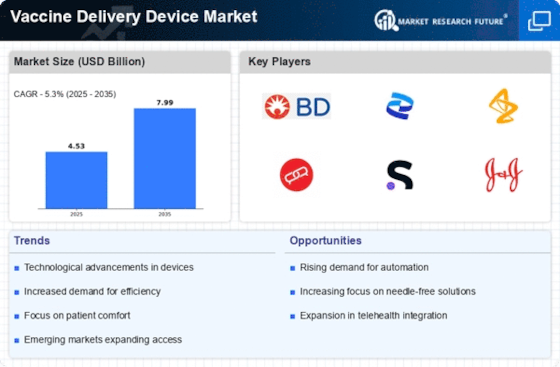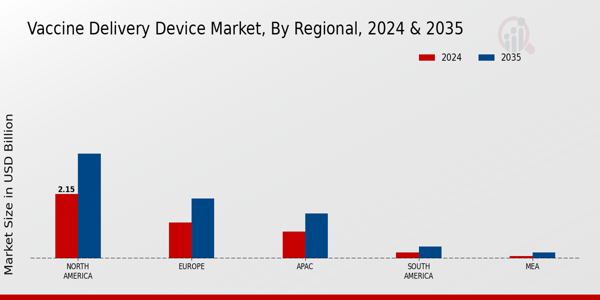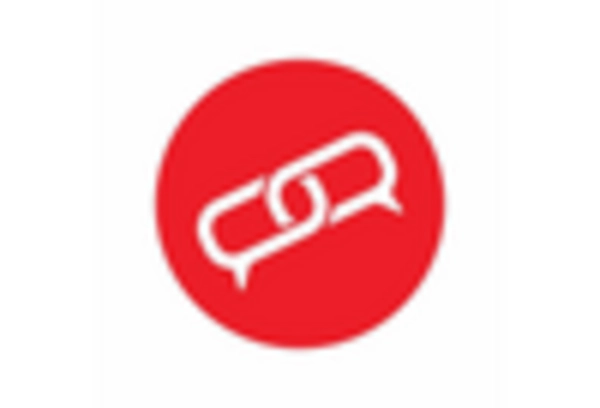Technological Innovations
Technological advancements are significantly shaping the Vaccine Delivery Device Market. Innovations such as needle-free delivery systems, micro-needle patches, and smart syringes are revolutionizing how vaccines are administered. These technologies not only improve patient comfort but also enhance the accuracy and efficiency of vaccine delivery. For instance, needle-free devices have been shown to reduce the risk of needle-stick injuries, which is a growing concern in healthcare settings. The market for these advanced delivery systems is projected to expand, with estimates suggesting a compound annual growth rate of over 10% in the coming years. As healthcare providers increasingly adopt these technologies, the Vaccine Delivery Device Market is likely to witness a transformation that aligns with modern healthcare needs.
Rising Demand for Vaccination
The Vaccine Delivery Device Market is experiencing a notable increase in demand for vaccination, driven by heightened awareness of preventive healthcare. As populations become more health-conscious, the need for effective vaccine delivery systems has surged. According to recent estimates, the vaccination rates have shown a steady upward trend, with projections indicating that the market could reach a valuation of approximately USD 5 billion by 2026. This growth is further fueled by government initiatives aimed at increasing vaccination coverage, particularly in underserved regions. The emphasis on immunization programs has led to innovations in vaccine delivery devices, enhancing their efficiency and accessibility. Consequently, the Vaccine Delivery Device Market is poised for substantial growth as stakeholders recognize the critical role of vaccination in public health.
Regulatory Support and Funding
Regulatory support and funding initiatives are playing a crucial role in the Vaccine Delivery Device Market. Governments and regulatory bodies are increasingly recognizing the importance of efficient vaccine delivery systems in achieving public health goals. This recognition has led to the establishment of favorable policies and funding programs aimed at supporting the development and distribution of innovative vaccine delivery devices. For instance, recent funding allocations for vaccine research have exceeded USD 1 billion, facilitating advancements in delivery technologies. Such support not only accelerates the development of new devices but also enhances their accessibility in various healthcare settings. Consequently, the Vaccine Delivery Device Market is expected to thrive as regulatory frameworks evolve to promote innovation and ensure the availability of effective vaccine delivery solutions.
Increased Focus on Preventive Healthcare
The Vaccine Delivery Device Market is benefiting from a growing emphasis on preventive healthcare measures. Governments and health organizations are increasingly advocating for vaccination as a primary strategy to combat infectious diseases. This shift in focus is reflected in the rising investments in vaccine research and development, which have reached unprecedented levels. The market is projected to grow as healthcare systems prioritize preventive measures, with an estimated increase in vaccine delivery device sales by 15% annually. This trend is further supported by public health campaigns that aim to educate populations about the importance of vaccinations. As a result, the Vaccine Delivery Device Market is likely to expand, driven by the collective efforts of stakeholders to enhance public health outcomes.
Growing Awareness of Vaccine Safety and Efficacy
The Vaccine Delivery Device Market is witnessing a surge in awareness regarding vaccine safety and efficacy. As public discourse around vaccination continues to evolve, there is a growing recognition of the importance of safe and effective vaccine delivery systems. This awareness is driving demand for devices that ensure optimal vaccine storage, handling, and administration. Recent surveys indicate that over 70% of individuals express confidence in vaccines when informed about their safety protocols. This trend is likely to bolster the market, as healthcare providers seek to adopt devices that align with public expectations. The Vaccine Delivery Device Market is thus positioned to benefit from this heightened awareness, as stakeholders strive to enhance the overall vaccination experience.


















Leave a Comment